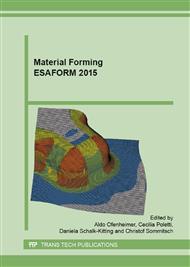[1]
A. Considère, Mémoire sur l'emploi du fer et de l'acier dans les constructions, Ann. Ponts et Chausées. 9 (1885), 574-775.
Google Scholar
[2]
D.C. Drucker, Some implications of work hardening and ideal plasticity, Q. Appl. Math. 7 (1950), 411-418.
DOI: 10.1090/qam/34210
Google Scholar
[3]
R. Hill, A general theory of uniqueness and stability in elastic-plastic solids, J. Mech. Phys. Solids. 6 (1958), 239-249.
Google Scholar
[4]
Z. Marciniak, K. Kuczynski, Limit strains in processes of stretch-forming sheet metal, Int. J. Mech. Sci. 9 (1967), 609-620.
DOI: 10.1016/0020-7403(67)90066-5
Google Scholar
[5]
S. Stören, J.R. Rice, Localized necking in thin sheets, J. Mech. Phys. Solids 23 (1975), 421-441.
DOI: 10.1016/0022-5096(75)90004-6
Google Scholar
[6]
M. Ben Bettaieb, F. Abed-Meraim, Investigation of localized necking in substrate-supported metal layers: Comparison of bifurcation and imperfection analyses, International Journal of Plasticity 65 (2015), 168-190.
DOI: 10.1016/j.ijplas.2014.09.003
Google Scholar
[7]
J.W. Hutchinson, K.W. Neale, Sheet necking – II. Time-independent behavior. In: Koistinen, D.P., Wang, N.M. (Eds. ), Mechanics of Sheet Metal Forming. Plenum, 1978, pp.127-153.
DOI: 10.1007/978-1-4613-2880-3_6
Google Scholar
[8]
K. Yoshida, M. Kuroda, Numerical investigation on a key factor in superior stretchability of face-centered cubic polycrystalline sheets, Int. J. Mech. Sci., 58 (2012), 47-56.
DOI: 10.1016/j.ijmecsci.2012.02.009
Google Scholar
[9]
G. Franz, F. Abed-Meraim, M. Berveiller, Strain localization analysis for single crystals and polycrystals: Towards microstructure–ductility linkage, International Journal of Plasticity 48 (2013), 1-33.
DOI: 10.1016/j.ijplas.2013.02.001
Google Scholar
[10]
J.W. Hutchinson, V. Tvergaard, Shear band formation in plane-strain, Int. J. Solids Struct., 17 (1981), 451-470.
DOI: 10.1016/0020-7683(81)90053-6
Google Scholar
[11]
H.K. Akpama, M. Ben Bettaieb, F. Abed-Meraim, Numerical integration of rate-independent BCC single crystal plasticity models: comparative study of two classes of numerical algorithms, submitted to Comput. Meth. Appl. Mech. Eng.
DOI: 10.1002/nme.5215
Google Scholar
[12]
C. Miehe, J. Schröder, J. Schotte, 1999. Computational homogenization analysis in finite plasticity. Simulation of texture development in polycrystalline materials. Comput. Meth. Appl. Mech. Eng. 171, 387-418.
DOI: 10.1016/s0045-7825(98)00218-7
Google Scholar


